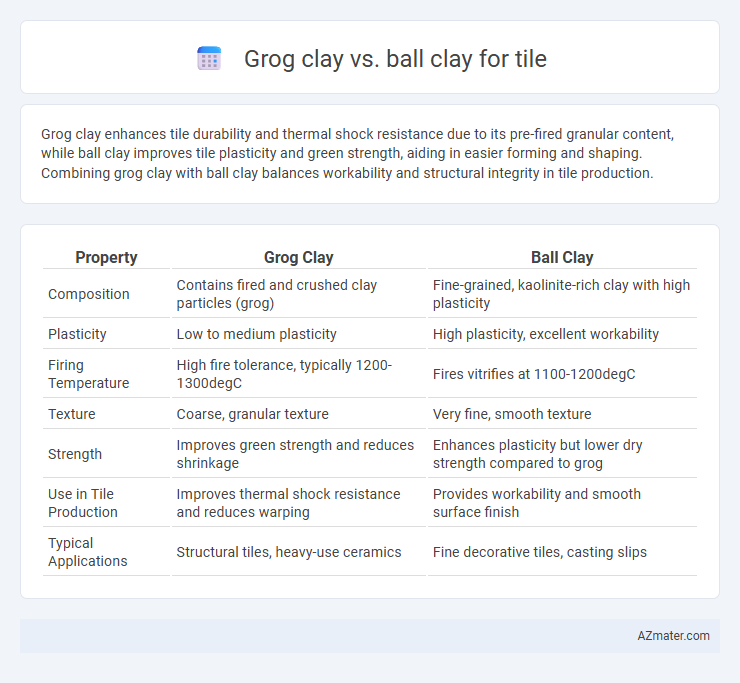Grog clay enhances tile durability and thermal shock resistance due to its pre-fired granular content, while ball clay improves tile plasticity and green strength, aiding in easier forming and shaping. Combining grog clay with ball clay balances workability and structural integrity in tile production.
Table of Comparison
| Property | Grog Clay | Ball Clay |
|---|---|---|
| Composition | Contains fired and crushed clay particles (grog) | Fine-grained, kaolinite-rich clay with high plasticity |
| Plasticity | Low to medium plasticity | High plasticity, excellent workability |
| Firing Temperature | High fire tolerance, typically 1200-1300degC | Fires vitrifies at 1100-1200degC |
| Texture | Coarse, granular texture | Very fine, smooth texture |
| Strength | Improves green strength and reduces shrinkage | Enhances plasticity but lower dry strength compared to grog |
| Use in Tile Production | Improves thermal shock resistance and reduces warping | Provides workability and smooth surface finish |
| Typical Applications | Structural tiles, heavy-use ceramics | Fine decorative tiles, casting slips |
Introduction to Grog Clay and Ball Clay
Grog clay consists of pre-fired clay particles mixed into raw clay to improve strength and reduce shrinkage, making it ideal for tile production where durability is key. Ball clay is a highly plastic, fine-grained sedimentary clay that enhances workability and smoothness in tile forming, offering excellent plasticity and firing properties. Both grog clay and ball clay are essential in tile manufacturing for balancing strength, texture, and firing performance.
Composition and Mineral Content
Grog clay contains crushed fired clay particles mainly composed of alumina (Al2O3), silica (SiO2), and fluxing oxides, enhancing thermal shock resistance and reducing shrinkage in tiles. Ball clay is characterized by a fine particle size with high plasticity, primarily consisting of kaolinite, mica, and quartz, contributing to tile plasticity and strength. The differing mineral contents in grog and ball clays determine their complementary roles in optimizing tile durability and workability.
Physical Properties Comparison
Grog clay offers higher thermal shock resistance and reduced shrinkage during firing compared to ball clay, making it ideal for durable tile production. Ball clay features fine particle size and high plasticity, contributing to excellent workability and smooth surface finish in tiles. The density of grog clay is typically lower, enhancing porosity and mechanical strength, whereas ball clay's higher density increases the tile's overall weight and brittleness.
Workability and Plasticity
Grog clay offers improved workability for tile production due to its coarse particles that enhance drying and firing stability, reducing shrinkage and warping. Ball clay exhibits high plasticity with fine, smooth particles, allowing for excellent moldability and shaping but requires careful drying to prevent cracking. Selecting between grog and ball clay depends on balancing the need for formability versus structural integrity in tile manufacturing.
Firing Temperatures and Behavior
Grog clay contains pre-fired particles that improve thermal resistance and reduce shrinkage during firing, making it suitable for high-temperature applications above 1200degC, while ball clay offers fine particle size and plasticity but fires at lower temperatures around 1100-1180degC and can lead to more shrinkage. The coarse grog texture enhances structural integrity and prevents warping, whereas ball clay's smooth texture promotes workability but requires precise firing control to avoid deformation. Combining grog with ball clay can optimize tile durability and dimensional stability across a wider firing temperature range.
Tile Strength and Durability Factors
Grog clay enhances tile strength and durability by adding coarse, fired clay particles that increase resistance to cracking and thermal shock. Ball clay, known for its fine particle size and plasticity, improves tile workability and density but offers less impact on structural reinforcement compared to grog. The incorporation of grog in tile bodies typically results in more robust, long-lasting tiles ideal for high-stress applications requiring superior mechanical performance.
Surface Texture and Finish
Grog clay enhances tile surface texture by adding coarse granular particles that improve slip resistance and create a rustic, matte finish ideal for non-slip flooring applications. Ball clay offers a finer, smoother surface texture due to its tiny, plastic particles, resulting in a glossy, highly polished finish favored for decorative tiles. The choice between grog clay and ball clay directly influences tile durability and aesthetic appeal through differences in surface roughness and finish quality.
Porosity and Water Absorption
Grog clay contains coarse fired particles that increase porosity and reduce water absorption, making it suitable for tile bodies requiring improved thermal shock resistance and structural strength. Ball clay, with its fine, plastic particles, offers low porosity and higher water absorption, enhancing tile workability but potentially reducing durability in wet conditions. Balancing grog clay and ball clay proportions optimizes tile porosity and water absorption, ensuring desired mechanical properties and moisture resistance.
Suitability for Different Tile Types
Grog clay, with its coarse alumina particles, provides excellent thermal shock resistance, making it ideal for heavy-duty tiles such as floor and industrial tiles that require enhanced strength and durability. Ball clay's fine particles and high plasticity suit delicate applications like ceramic wall tiles and fine china, enabling smooth surfaces and intricate designs. Choosing grog clay enhances structural integrity in high-impact environments, while ball clay ensures better workability and aesthetic finish in thinner, ornamental tile types.
Cost-Effectiveness and Availability
Grog clay offers greater cost-effectiveness for tile production due to its lower price and reduced shrinkage, minimizing waste and kiln firing costs. Ball clay, while more expensive, provides superior plasticity and strength, but its limited availability can drive up procurement expenses. Manufacturers often prefer grog clay for bulk tile manufacturing where budget and material availability are critical.

Infographic: Grog clay vs Ball clay for Tile
 azmater.com
azmater.com